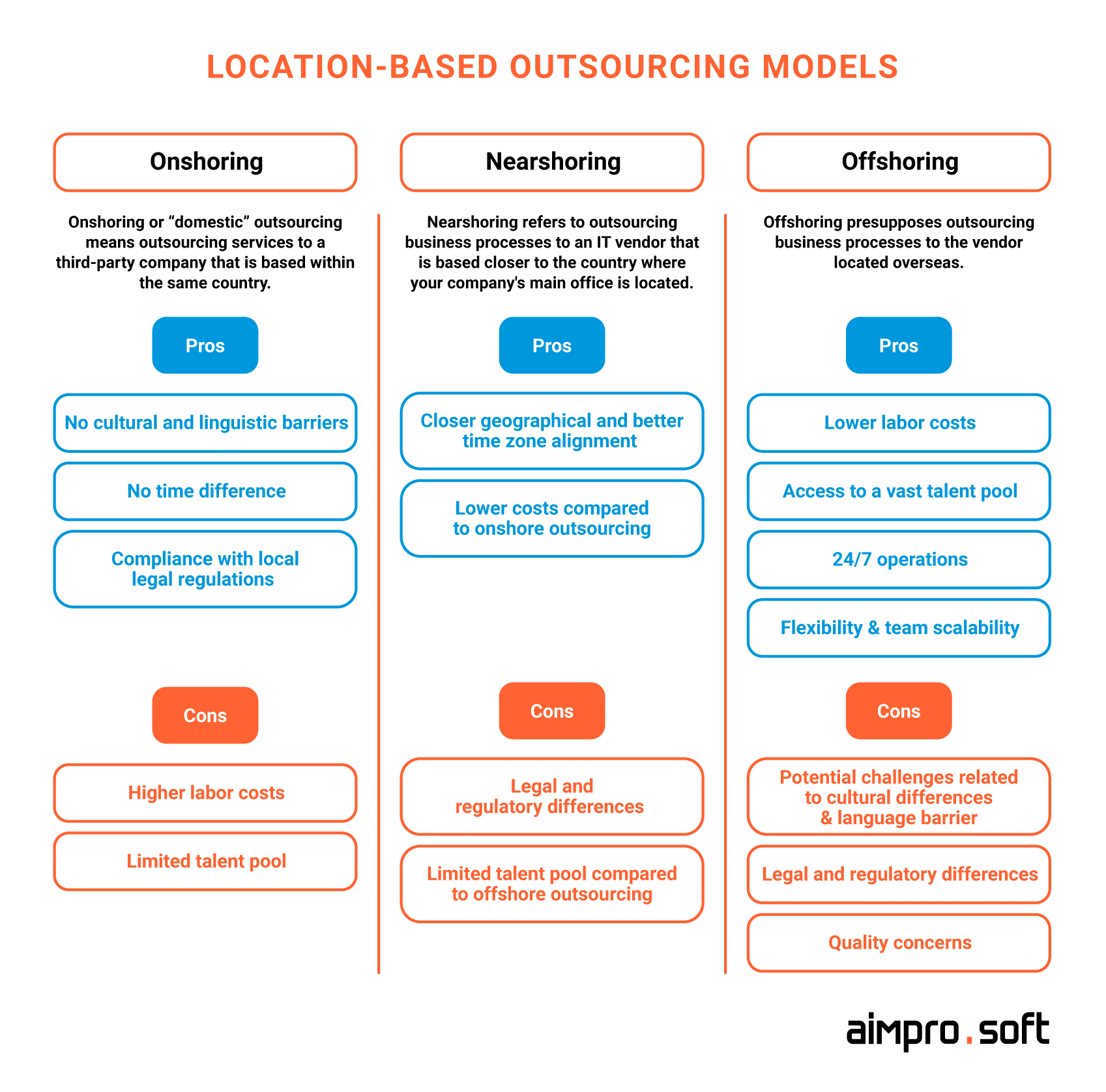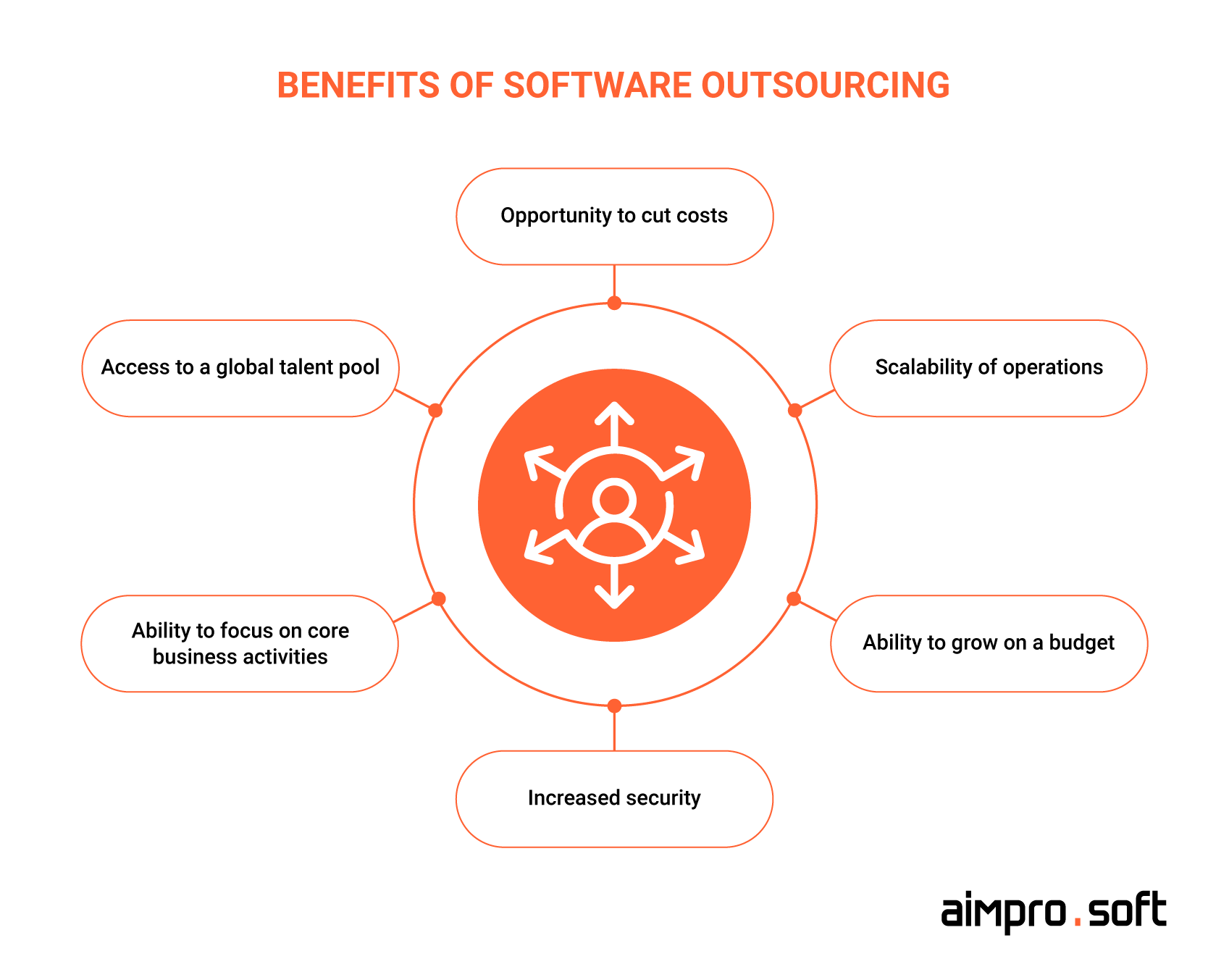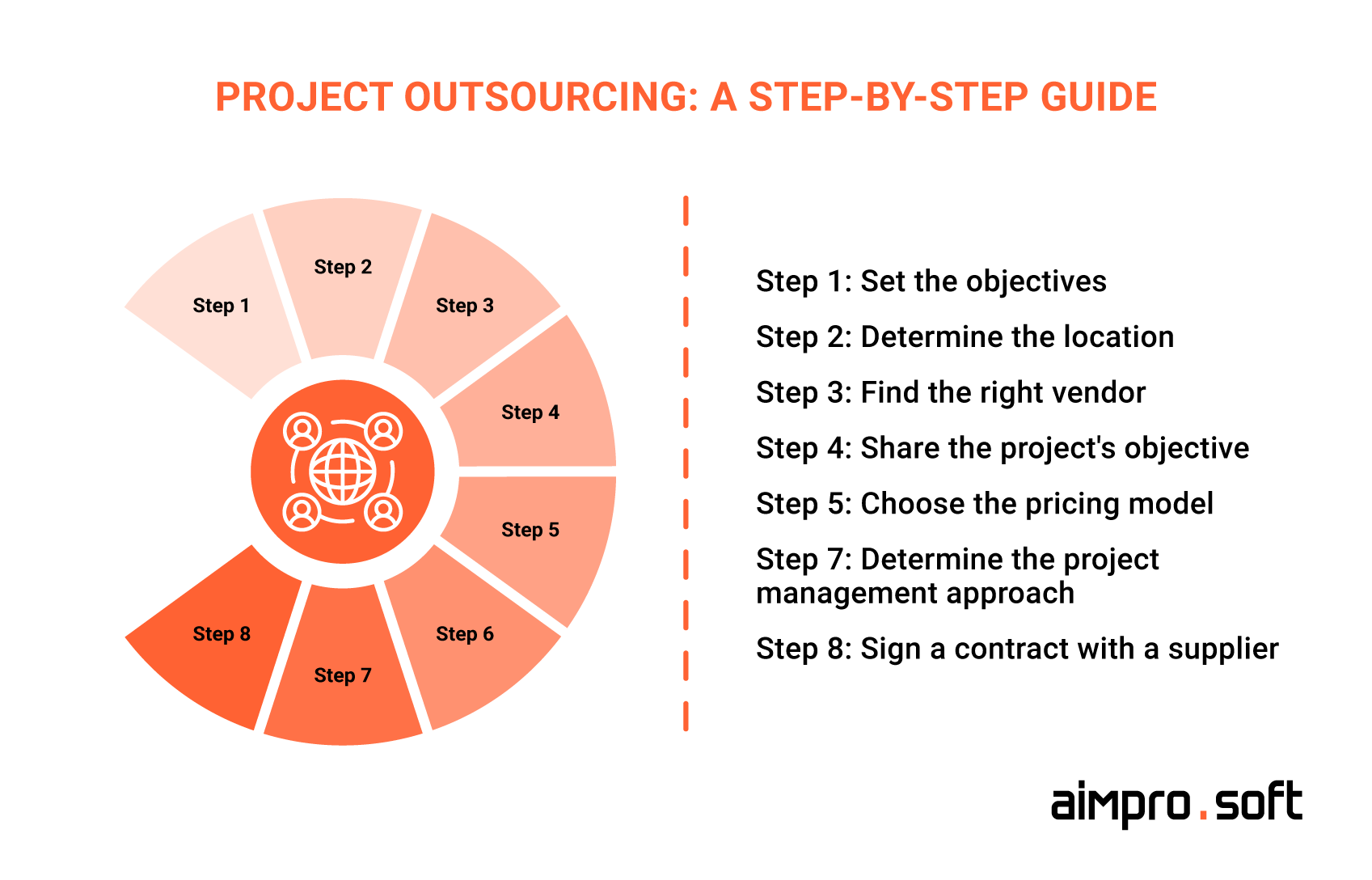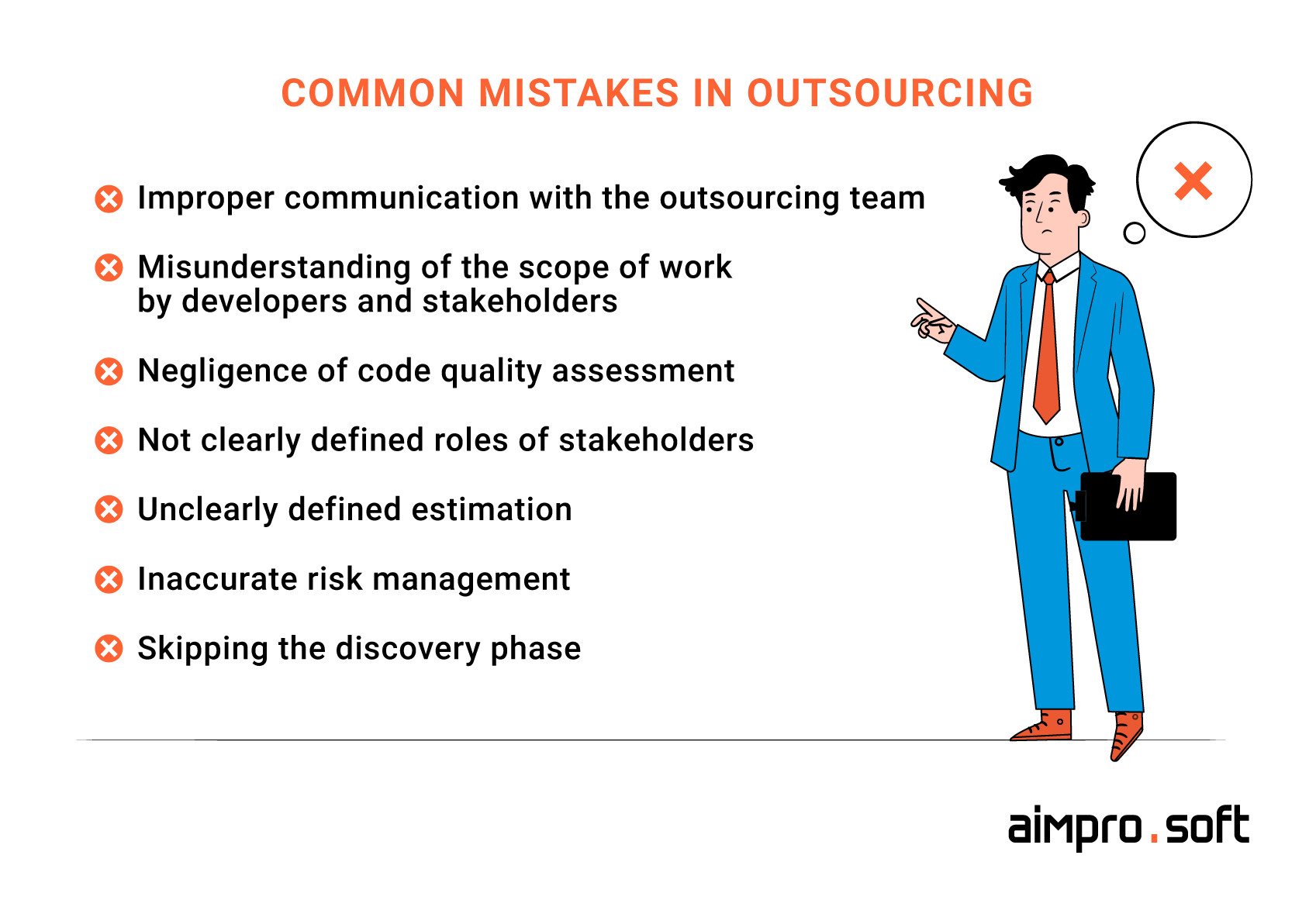The Complete Guide to Software Development Outsourcing

Key takeaways
- Learn more about outsourcing, its types, and how to choose the suitable type for your project.
- Cost savings, flexible team scaling, and accelerated time-to-market are only a few examples of benefits that outsourcing can bring you. Learn more about the pros of outsourcing and how it can become your key to sustainable business success.
- How to build a software development outsourcing flow to increase the chances of a positive outcome? Find out more in our detailed step-by-step guide.
- Before outsourcing your project, it’s crucial to conduct a careful vendor assessment. Learn how to choose a reliable provider and avoid risks.
- Discover the truth about outsourcing and dispel the myths that stop entrepreneurs from using this approach.
- How can you avoid outsourcing risks? We’ve put together a strategy for you to bypass the most common mistakes associated with outsourcing.
- Explore our overview of the most popular trends in outsourcing to keep up with a fast-paced market and stay ahead of your competition.
Nowadays, companies often find themselves pressed by challenges that increase a precarious position in a fast-paced market. The never-ending race for competitiveness, the lack of seasoned specialists in the local market due to talent shortage, the need for strategic shifts, and a rapidly evolving technological landscape are just a few examples of those barriers that prevent businesses from achieving their objectives. In the face of these obstacles, outsourcing often seems both a tempting opportunity and a frightening option. You may find yourself in a similar position 一 weighing the potential benefits of software development outsourcing against lingering doubts and uncertainties.
Yes, the decision to outsource software development can be difficult, and concerns about quality, communication barriers, and minimal control of critical processes can be daunting. However, despite these concerns, the benefits of outsourcing far outweighthe mentioned disadvantages, especially considering the astounding growth of the industry for the past years, which is expected to exceed $1 trillion within the next 6 years. To dispel your doubts, let us guide you through the world of outsourcing, providing you with insights, practical tips, and ideas to help you use its full potential.
Navigating software engineering outsourcing
Software development outsourcing is a business strategy that presupposes the decision of a business to delegate product development to a third-party IT vendor instead of using its internal resources. This approach allows organizations to benefit from the specific competencies and knowledge of remote teams and reduce costs, increasing internal productivity and workforce availability.
There are many ways to outsource software, including staff augmentation, a dedicated team, where external teams work alongside internal teams, or full project outsourcing, where a hired IT company like Aimprosoft runs the entire project itself. However, these options are not the only types of IT outsourcing. Thus, let’s talk in detail about the different types of outsourcing below.
Types of software outsourcing
Regarding types of outsourcing software development they can be divided into two main categories: location and model-based. These categories aren’t mutually exclusive. Instead, these are two approaches to categorizing types of outsourcing.
Location-based outsourcing
Choosing the right outsourcing location has a direct impact on the success of the project and the way of collaboration with the vendor. The location of the provider affects the cost, quality, and availability of services. Let’s consider the difference between onshoring, nearshoring, and offshoring.

Location-based outsourcing models
Onshore
The onshore model means hiring a team from your country. One time zone, the same language, and mostly the same mentality and cultural context greatly simplify the work. You can easily plan your time and stay in touch with the team. This model is well suited for businesses that prefer geographic and time convenience. However, this type of cooperation is costly. If your company needs to optimize costs, this option will unlikely be right for you.
Nearshore
Nearshoring presupposes hiring a team from neighboring countries that are located in similar time zones, facilitating convenient communication. Compared to onshore, the advantage of nearshore outsourcing is the cheaper cost of labor. Additionally, proximity and timezone alignment, agile collaboration, and higher control of development processes are other key benefits of this type of outsourcing that will allow you to develop software in a convenient manner.
Offshore
Offshoring means hiring employees in radically different time zones. You can employ a team from another continent. For example, countries such as the Czech Republic, Poland, and Ukraine are the leading destinations for high-quality outsourced software development in the US market. Offshoring can reduce costs in various areas.
First and foremost, it is about paying for human resources allocated to the project, and offshoring also involves tax cuts and the maintenance of a team in another country. But at the same time, be prepared that you will have to come face to face with a foreign mentality and a big time difference. But you can deal with this if you carefully prepare a project management strategy that will allow you to create a smooth workflow.
Model-based outsourcing
Model-based outsourcing refers to the different approaches or models that organizations can adopt when outsourcing the specific scope of the projects or opting for end-to-end outsourcing.
| Criteria | Staff augmentation | End-to-end project outsourcing | Dedicated team |
|---|---|---|---|
| Client involvement | High client involvement with direct management. | Low involvement without direct team management. | High client control and active involvement in strategic planning. |
| Flexibility | Offers flexibility in adjusting the team size. | Limited flexibility during the project, as the scope is usually predefined. | Medium flexibility, sometimes allowing for adjustment to changing requirements. |
| Project scope | Ideal for projects requiring specific skills temporarily. | Suitable for well-defined projects with clear specifications. | Best for extensive, long-term projects with evolving requirements. |
| Communication | Direct communication with the extended team on a daily basis. | Communication is usually mediated through project managers, but not frequently. | Direct communication with the dedicated team occurs quite often. The project can be managed either on the client’s side or by the vendor’s PM with close cooperation with the client. |
| Duration of cooperation | Short to medium-term engagements based on project needs. | Typically, short to medium-term projects with a defined timeline (long-term cooperation is also possible). | Long-term partnerships with ongoing collaboration. |
| Project focus | Task-oriented within existing projects. | The entire project is outsourced to the partner. | The team focuses on completing the scope of work of the existing project or the entire project. |
Staff augmentation
Synonyms: outstaffing, IT staffing, staff extension
Staff augmentation is a model that allows business owners to expand their teams with specialists hired from third-party IT vendors. Although outstaffing is considered one of the forms of outsourcing, there is still a drastic difference between staff augmentation and classical end-to-end project outsourcing. Outsourcing involves transferring a certain amount of work or an entire project to another company. In the case of staff augmentation, you hire certain specialists who are working in another company to expand your team due to lacking specialists for a term determined by you.
Key specifics:
- Temporary resource augmentation
Staff augmentation temporarily supplements existing company employees with external talent, allowing for flexibility to scale resources as needed.
- Collaboration with third-party vendors
External talent is often hired from third-party vendors or agencies, providing the specialized skills required for specific projects.
- Engaging for a limited time
Additional staff is typically hired for project-based work or to fill gaps in specific skills for a limited period, offering a cost-effective solution to short-term needs.
- Flexibility and scalability
The model provides companies with the flexibility to manage resources, allowing them to increase or decrease in number depending on project needs without the long-term commitment of hiring full-time staff.
Pros: Scalability and flexibility, efficient allocation of resources, reduced administrative burden.
Cons: Communication challenges, quality control, the complexity of specialists integration.
Project outsourcing
Synonyms: software outsourcing, IT outsourcing, end-to-end outsourcing
Project outsourcing means delegating specific projects or tasks to external software service providers instead of handling them in-house. This approach allows organizations to leverage external expertise, resources, and capabilities to fulfill specific project objectives efficiently and effectively.
Key specifics
- Focus on specific tasks
Project outsourcing is task-oriented and aims to achieve specific project objectives within a defined timeframe.
- Involvement
As a rule, project outsourcing is a time-limited engagement with a clear start and end date with a low client involvement.
- Scope definition
Project outsourcing involves clearly defined tasks or projects with specific deliverables and goals.
- Goal-oriented
The focus is on achieving specific project objectives, whether it is software development, marketing campaigns, or other one-off initiatives.
Pros: Clear definition of project scope, reduced administrative overheads, fast project realization.
Cons: Dependence on external vendors, low control of the processes, limited scalability.
Dedicated teams
Synonyms: dedicated development team, extended team, managed team
A dedicated development team is a group of software development specialists who work directly with a customer or a specific part of the project on the entire project. The team usually includes developers, testers, project managers, and other specialists who work together to create high-quality software products.
Key specifics
- A deeper understanding of the project
Teams that create dedicated software for companies remain focused solely on a particular one, which facilitates a deeper understanding of the product and the client’s requirements, goals, and vision.
- Cross-functional expertise
The dedicated team comprises professionals with diverse skills, such as developers, designers, and QA engineers, providing comprehensive project support.
- Full-time employment
Team members are solely dedicated to the client’s project, working as if they are an integral part of the in-house team, ensuring complete dedication and focus.
- Client control
Although the dedicated team works remotely, the client retains control over project management, priorities, and communications, which promotes transparency and collaboration.
Pros: Full control over resources, seamless integration, building long-term relationships, team alignment with company culture.
Cons: Takes more time and effort to set up, less flexible compared to outstaffing.
How to choose a model that best fits your needs
Choosing a suitable outsourcing model can be difficult; when selecting one, it’s important to align it with your organization’s specific needs and goals. That’s why we’ve put together some useful tips to help you decide:
- Assess your business requirements
Start by comprehensively assessing your business needs. It is essential to pinpoint the key challenges that necessitate outsourcing and clearly define the specific project requirements. When articulating your initial needs, eliminate any potential ambiguity. The more precise your requirements, the more effectively you can align them with the optimal outsourcing model.
- Evaluate the level of control over the project you want to have
Assess the degree of control you want to have over your project at this stage. It would be best to decide whether you are comfortable relinquishing control to an outsourcing partner’s expertise or prefer to keep a close eye on the progress of the work. It is essential to find the right balance between control and delegation.
- Consider project complexity
Determine whether your outsourcing needs are short-term or long-term. Choose a project-oriented outsourcing approach for work requiring specialized skills under a specific, time-limited contract. Alternatively, consider a dedicated team or managed services model for ongoing support and continuous service.
- Determine the budget
Project-based outsourcing provides cost predictability for fixed-scale projects, while dedicated team or staff augmentation models offer flexibility to scale resources. On the other hand, offshoring can provide cost advantages over time but also require a large initial investment.
- Degree of involvement
Determine your desired level of engagement in the development processes. Dedicated teams or staff augmentation models provide more direct interaction with the hired specialists, while project-based outsourcing models suit those comfortable with the lowest degree of involvement.
- Legal and intellectual property protection
Assess legal and intellectual property considerations. Ensure the chosen outsourcing model includes appropriate legal agreements, confidentiality measures, and intellectual property protection.
Having doubts whther to outsource or choose good old in-house development? Read our article comparing the two approaches and find out which one is better for you.
We have looked at the outsourcing approach and its main types so that you can understand which type is right for your business. But why is it worth outsourcing software development apart from the obvious reasons? Let’s find out the answer to this question in our next section.
Benefits of global software outsourcing
It’s no secret that outsourcing can be a profitable solution for companies of all sizes. Outsourcing can save you money, make hiring faster and more convenient, and give you access to a global talent pool. Let’s focus on the benefits of outsourcing software development to give a full picture of what you get if you choose this collaborative model.

Benefits of software outsourcing
Cost reduction
Outsourcing allows companies to tap into a global talent pool, often in regions with lower labor costs, but without affecting quality. Also, companies can avoid the expenses associated with hiring and training new employees by outsourcing certain tasks. This results in significant savings on salaries and related costs. On average, all of these influencers contribute to the fact that outsourcing can reduce costs by 30-50%.
Access to a global talent pool
It is known that 59% of businesses outsource in order to access global talent pools. Outsourcing allows organizations to use a diverse and specialized talent pool worldwide. This access allows them to utilize the expertise that may not be available locally. It’s also about price, as outsourcing to regions with lower labor costs enables companies to benefit from skilled professionals without incurring high costs. So you can save a significant amount of cost compared to hiring locally.
Ability to focus on core business activities
Referring to Forbes, by outsourcing some non-strategic functions, such as product maintenance, you free up internal resources for other essential aspects of your business, such as customer service and building your company’s strategies and overall goals. It’s no secret that a key objective of any business owner is to focus on strategic leadership rather than trying to control every aspect of the company. By outsourcing software projects development or existing software support to external partners, a business can focus on the company’s primary functions. Outsourcing non-core tasks fuels company growth by ensuring efficient resource allocation.
Flexibility to expand or reduce the scale of operations
Forbes states that as your business grows, you can easily scale up or down depending on your needs with outsourcing. You can increase your staff from an outsourcing company if your project needs to expand, or you can do the opposite. This really reduces the time to hire new specialists and replace employees, so this leads to faster product launch.
Ability to grow on a budget
Outsourcing is a strategic tool for entrepreneurs seeking to expand their business while meeting budget constraints. Software development is a case in point. Many companies may not need an in-house software development outsource team. However, they require specialized software solutions to improve operations and customer service. Instead of building an in-house team from scratch, companies can leverage external expertise to create specialized software solutions. This approach allows entrepreneurs to allocate resources efficiently, focusing on their core business while benefiting from dedicated technical expertise.
Increased security
While 91% of IT companies have their internal security teams, 83% are considering outsourcing security in the future. When organizations partner with reputable outsourcing companies, they gain access to a pool of skilled professionals. These experts keep up with the latest trends and best practices in cybersecurity, ensuring that the software developed is protected from potential threats. In addition, outsourcing companies often invest in advanced security technologies and protocols, providing an extra layer of protection.
By leveraging the expertise and resources of outsourcing partners, companies can effectively mitigate risks, address vulnerabilities, and strengthen the overall security of their software products.
Although there are far more outsourcing software development advantages than we have listed above, our goal was to cover those that show crucial positive changes that outsourcing can bring to your business. Businesses choose this approach because it is convenient and cost-efficient, as the statistics above show. Let’s consider how to choose a reliable outsourcing service provider, as well as what the outsourcing process looks like in general.
The software outsourcing process explains: a step-by-step overview of project outsourcing
Before you start developing your product, there are several important steps to follow, such as clearly defining the goals of your product, finding a suitable payment model, choosing a reliable supplier, etc. That’s why we have compiled a guide for you on all the essential procedures that go into a successful outsourcing process.
Project outsourcing flow: from definition to contract signing

A step-by-step guide to project outsourcing
Step 1: Set the objectives
Clearly defining the goals of your project is critical to outsourcing success. It involves defining what you want to achieve through outsourcing, setting specific goals, and establishing clear expectations for project outcomes. By defining goals in advance, you create a roadmap for the outsourcing software development process, ensuring a match between your business needs and the outsourcing provider’s capabilities. This step lays the foundation for effective communication, helps you evaluate potential outsourcing partners, and facilitates decision-making throughout the project.
Step 2: Determine the location where you want to hire the supplier
One of the main advantages of outsourcing is the reduction of software development costs. More often than not, these savings depend precisely on the location where the outsourcing partner is located. There are many outsourcing destinations that offer lower hourly rates for developers. For example, the hourly rate of an engineer in the USA is 95-110$, in Germany, the rate is 85-95$, if you look at the hourly rate of developers in Ukraine, it is 45-55$.
Such rates are influenced by factors such as cost of living, taxes, average salaries in the country, demand, and other considerations. As a result, by choosing the option that seems the most favorable to you, you may not worry about the quality of the work. Thus, by choosing the perfect location, you can save a significant amount of money.
Step 3: Searching for the right company
Finding a reliable outsourcing software development provider is really made easier by platforms that contain flattering lists of outsourcing companies and can provide reviews and their ratings. Such platforms will help you make an informed decision, so below is a list of such sites so you know where to look:
These platforms provide detailed and comprehensive lists of IT outsourcing companies, saving entrepreneurs hours of search time. Reviews and ratings on these platforms are based on real customer experiences, which gives insight into the strengths and weaknesses of outsourcing companies. We’ll discuss how to choose the right vendor in more detail in the next section.
Step 4: Share the project’s objectives and clear requirements
So you have found the right IT vendor and are contacting them. When you contact the company and ask for assistance in project development, you will be requested to provide technical requirements, key business objectives, and project development strategy. However, the client often does not provide sufficient requirements for the project, making it impossible to produce a detailed estimate. Then, we need to take the next step – the discovery phase.
Step 5: Choose the pricing model correctly
When you embark on outsourcing, choosing the right payment model is essential, as it significantly impacts project results and financial management. So, let’s compare two popular payment models:
Fixed price model
According to the project specification and the expected scope of work, the software vendor in this model offers a fixed price for a particular project. It is best suited for projects with a well-defined scope of work, specific deliverables, and deadlines.
Pros:
- Budget certainty
- Defined scope of work
- Reduced risk to the client
Cons:
- Limited flexibility
- Risk of misunderstandings
Time and materials model
In this business model, the supplier bills the client according to the time and resources required to complete the job. The advantage of this model is that it provides greater flexibility, allowing the needs and scope of the project to be adjusted as required. Suitable for projects with changing requirements, uncertain scope, or projects that require flexibility.
Pros:
- Flexibility, easy-to-make changes
- Ability to monitor project progress
- Adaptability to changing requirements
Cons:
- Unpredictable budget
- Unforeseen costs may arise
Step 7: Determine the approach to project management
Before signing a contract with a vendor, it is worth considering who will manage your project. Hiring a project manager to liaise between you and development team members is highly recommended. The project manager will select reliable communication channels to inform you of progress and offer a new perspective on the project. Project management services can also be outsourced, which can be very beneficial for the development team if the PM works together with them on the same project and with the same IT vendor. This way, finding a common language between the developers and the manager will be easier and faster.
Step 8: Sign a contract with a supplier
Now, you and the vendor must sign a contract that should clearly spell out payment requirements, deliverables, deadlines and penalties associated with failure, and more. Once this is done, you can sign the contract and begin the development process. By following this sequence and not excluding any of the above steps, you can save your budget, reduce the risk of miscommunication with the hired team, and increase the chances of your product’s success.
So, we have covered the key steps in the outsourcing software development process. However, we need to draw your attention to one of the steps in more detail, namely the selection of a reliable outsourcing provider.
Evaluating software development companies: tips for choosing the right vendor
Working with an unreliable software vendor is one of the most common outsourcing mistakes. You risk missing development deadlines, getting a low-quality product that will have to be redesigned, and having confidential data leaked to third parties. However, this problem can be solved if you choose your vendor carefully. So, how do you check the reliability of a supplier? Here are some tips from us:
Examine reviews from previous clients
When choosing a reliable outsourcing service provider, it is vital to study the experience of previous clients. Checking reviews on the independent platforms we mentioned above provides valuable information about the provider’s performance, professionalism, and adherence to deadlines. By evaluating reviews and ratings, you can get a complete picture of the supplier’s strengths and weaknesses and reputation in general, which will help you make an informed decision.
Explore the experience of the potential vendor
Examining the vendor’s portfolio is equally important, as it clearly demonstrates their capabilities and experience. Look for examples of projects similar in scope, complexity, and industry to yours. By analyzing previous work, you will be able to assess the vendor’s proficiency in delivering solutions that meet your requirements and ensure that they have the necessary skills and experience to address your project’s challenges effectively.
Assess company’s effectiveness in risk management
Ensure your supplier is well prepared for emergencies by assessing their contingency plans and ability to identify, evaluate, and control threats. Flexibility in a time-pressured and complex environment is essential. Therefore, require a report from the outsourcing company outlining strategies for maintaining project continuity and success in the event of unforeseen problems during development.
Before full-scale development, it’s better to run a trial period
Arrange a trial period with the vendor with the help of the discovery phase. This phase takes place before the product is implemented and helps define the project’s main objectives and gather all the requirements and necessary artifacts. During the discovery phase, a business analyst is involved in the project. The business analyst draws up a detailed project plan, analyses the target audience, identifies potential risks, and creates all the necessary documents for a full-fledged project launch. This step makes sense if it is practically impossible to go beyond the budget.
Learn more about the importance of the discovery phase to project success. Read our practical tips on the topic.
Make sure the company can protect your intellectual property
First, sign a non-disclosure agreement (NDA) when working with an outsourcing company. An NDA protects your confidential information and intellectual property by legally binding the provider to respect confidentiality. By setting clear data protection and confidentiality terms, you reduce the risk of unauthorized disclosure or misuse of confidential information, building trust and security in your outsourcing partnership. So before you enter any further discussions or cooperation, ensure your chosen supplier is willing to sign an NDA.
These tips can significantly reduce the risk of falling into the hands of an irresponsible vendor. We hope our tips will really help you in your search. However, the prejudices surrounding outsourcing stop most entrepreneurs from looking for an outsourcing provider. Well, in the next section, we will look at all these preconceptions and dispel them so that you can put all your doubts aside and get on with your search for a supplier.
Common misconceptions about software outsourcing
If any business approach is gaining popularity, myths and misconceptions around it are also rapidly growing. That is what happened with outsourcing. You may have heard that outsourcing is a threat to local employment, you may lose control over the product creation process or even get a poor-quality product due to lower development cost. That’s why we decided to dispel a few popular myths about this approach to help you overcome your doubts.

The most common outsourcing myths
Myth №1: Outsourcing implies low quality of completed work
Truth:
Many people assume that outsourcing offers lower prices and that the quality of services is as low as the cost. However, this presumption is not correct. Most often, such a cheap service rate in other regions is due to factors such as the lower cost of living in the country and the price of taxes. Therefore, qualified professionals may not charge high fees for their services. The point is that you can get poorly done work from your in-house team, and by finding a reliable supplier, you can avoid such an outcome.
Myth №2: Freelancing is a synonym for outsourcing
Truth:
A common myth revolves around the confusion between outsourcing and hiring freelancers. While both involve external resources, they are vastly different in nature and execution. The myth arises when people mistakenly use these terms interchangeably or believe that hiring a freelancer is synonymous with outsourcing. In reality, outsourcing involves a more strategic and comprehensive approach, often suited to large projects or ongoing collaborations with clearly defined timelines, contracts, and agreements. Freelancers, on the other hand, work independently and are often hired for specific tasks or short-term projects.
Myth №3: Only enterprises can profit from outsourcing
Truth:
There is a perception that only large companies can profit from outsourcing their projects. We are sure that this prejudice can demotivate small businesses and startups. However, outsourcing can benefit companies of any size. The outsourcing model has cost-effectiveness in its concept, so it is a good solution for companies with limited resources and not only for them. Outsourcing also allows small businesses to be competitive in the market next to the big players by utilizing skilled talent worldwide. This improves operational efficiency and fosters innovation by using different perspectives.
Myth №4: When you outsource a project, you lose control
Truth:
Most often, outsourced teams work on a project remotely, which can cause many entrepreneurs to fear losing control over the team because they are not communicating with them in person. But the blessing is that in today’s world, we have so many communication platforms that offer chat functions, video calls, and the ability to track the progress of a project. A well-chosen approach like Agile or Kanban can make the management process more accessible. Additionally, choosing a trusted outsourcing partner who is aware of your business values and goals will ensure that outsourcing teams work in tandem with your in-house staff, maintaining the vision and quality of the project.
Myth №5: Outsourcing is the enemy of your country’s economy
Truth:
Outsourcing is often unduly criticized by those who are not well informed; they say that this approach harms the economy. However, from an economist’s point of view, outsourcing plays a key role in strengthening the economic position of a country. Contrary to the narrow and biased viewpoint, outsourcing is an economic advantage for companies. Apart from financial benefits, it allows companies to reallocate internal talent to critical tasks that promote growth and business development within the country. Growing companies contribute to economic boost by offering superior goods and services.
Contact us, and we will offer you the best experts to bring your project to success.
CONTACT USNow that all the myths have been dispelled and the masks have been removed, you can proceed to outsourcing without preconceptions. We offer to learn more about how to make your cooperation with an outsourcing provider more successful and avoid all possible mistakes.
The crucial importance of outsourcing strategy
An efficient outsourcing strategy is a critical factor in ensuring the success of your partnership with a provider. But today, we’re going to approach the question of strategy from a different angle. What if we look at the major outsourcing failures and learn how to overcome them? Considering all possible mistakes and gaining knowledge on avoiding them, you can build up this perfect outsourcing strategy.
Pitfalls to avoid in software development outsourcing

Common mistakes in outsourcing
Overcoming communication barriers
The biggest advantage of outsourcing development is gaining access to a global talent pool. However, it also brings one of the biggest drawbacks ー communication issues. Establishing regular communication channels with the outsourced software development team becomes crucial to ensure project success. When communicating with outsourced developers, understanding the project requirements and being clear about the deliverables are the most important factors. So here are some tips to overcome communication barriers:
- Establish clear channels and protocols for communication from the outset.
- Schedule regular meetings to discuss progress, solve problems, and provide feedback.
- Use collaboration tools such as Jira or Asana.
- Encourage open communication and transparency between all stakeholders.
Scope understanding and management
One of the common mistakes in software outsourcing is a poor understanding of the project’s scope by the developers. With a clear understanding of the project scope, developers may interpret the requirements correctly, delivering outcome that was expected. On the contrary, a lack of clarity within the project scope can lead to delays, as developers may need to redesign features not originally defined or understood. To prevent this scenario, you should outline the frame and expectations accurately. Here are some tips on how to do that:
- Define project requirements and objectives comprehensively.
- Break down the project into manageable tasks with clear deliverables.
- Regularly review and adjust the scope as necessary, considering any changes in priorities or requirements.
- Ensure all stakeholders have a shared understanding of the project scope and goals.
Ensuring code quality
When code development is outsourced, there are challenges associated with quality assurance without technical expertise. Good code is clear, maintainable, well-documented, and tested. To maintain quality, set clear expectations, establish benchmarks, and communicate regularly. Your outsourced vendor should implement code validation and unit and functional testing. A robust quality assurance process that includes regression testing and issue management is critical. Here are more code quality assurance tips:
- Implement code reviews and quality assurance processes throughout the development lifecycle.
- Invest in continuous integration and deployment practices to optimize code delivery and deployment.
- Maintain a quality culture within the development team, focusing on best practices and standards.
Clarifying stakeholder roles
When stakeholder roles in outsourcing are unclear, it often leads to confusion, mismatched expectations, and project delays. Without a clear definition of who is responsible for what, duplication of responsibilities, conflicting instructions, and lack of accountability can occur. Furthermore, with clearly defined roles, the decision-making process can be smooth, leading to project delays and potentially impacting the overall success of the outsourcing. Here’s how to avoid it:
- Clearly define the responsibilities and expectations of each stakeholder involved in the project.
- Establish communication channels for stakeholders to provide input and feedback.
- Regularly communicate updates on project progress and decisions to all stakeholders.
- Address any conflicts or discrepancies in stakeholder roles promptly to maintain project momentum.
Undervalued expenses
Money can pose significant challenges in any project, regardless of its nature. Underestimating expenses often lead to incomplete software development projects. As the project progresses, unforeseen costs can emerge, negatively impacting its progress and overall quality. Financial difficulties frequently cause delays and compromise the final software product. Here are the actions you should take to prevent going over budget:
- Clearly define project deliverables upfront to estimate expenses accurately.
- Align expectations with the outsourced team regarding necessary expertise and team composition, such as developers, project managers, or quality assurance personnel.
- Obtain multiple quotes from developers to find a suitable match for your budget.
Risk management
Risk management in software development outsourcing is only possible if a defined protocol is established. Lack of risk management can lead to difficulties and disruptions in development, which requires preparing for worst-case scenarios like going severely over budget, over deadline, or failing to meet expectations. How to solve this problem:
- Create a comprehensive risk management plan with the help of IT.
- Be prepared for worst-case scenarios with a solid risk management plan.
- Develop specific strategies to address each type of problem identified in the plan.
Neglect of discovery phase
New product development is often complex and costly. Many companies make the mistake of assuming they can launch their product that will 100% shoot to market without conducting a discovery phase. Investing in thorough research and validation is essential to ensure ideas are viable before implementation. Your product discovery team should consist of a project manager, business analyst, developer, and software architect. This phase should include the following steps:
- Identifying current and potential business operations.
- Establishing current goals and expectations.
- Translating business requirements into functional steps.
- Presenting the project vision from an architecture perspective.
- Creating a project plan with risk assessment, budgeting, and release strategy.
The importance of the discovery phase is undeniable. Read our guide on the topic to see for yourself.
Outsourcing can be the best strategy to affordably scale and gain a competitive advantage, for business owners. However, before deciding to outsource software development, you need to understand all the risks and potential pitfalls clearly. Those are the risks we’ve covered in our section, but we’ve also given you tips to help you overcome them. Approach the outsourcing process competently, and success will be waiting for you.
Outsourcing trends in software development
In this ever-evolving field constantly transforming, trends change with surprising speed, sometimes disappearing as quickly as they appear. While the future leaves us to make only assumptions about outsourcing trends, we will highlight a few outsourcing services expected to be popular in 2024.
Noteworthy IT services outsourced
Let’s take a look at a few trending services that are likely to be outsourced more frequently in 2024.
QA & testing
For several reasons, outsourcing quality assurance (QA) and software testing services has become a prominent IT outsourcing trend. Firstly, companies increasingly realize the importance of delivering high-quality software to stay competitive and meet customer expectations. Outsourcing QA allows companies to access specialized expertise and resources dedicated solely to testing, ensuring a thorough and comprehensive quality assurance process.
Overall, the popularity of outsourcing QA services and software testing is due to its ability to improve product quality, speed time to market, and optimize costs, making it the preferred choice among companies looking to streamline their software development processes.
Cloud computing
The surge in digital transformation is driving organizations to shift from on-premises to cloud-based solutions, driving the growth of the global cloud computing market, which will reach $1,8 billions by 2032. With the increasing popularity of cloud-based systems, their development will be increasingly outsourced in 2024. Moving to the cloud offers benefits such as increased data security, faster data processing, and seamless integration of business applications. The software-as-a-service (SaaS) market will reach $232 billions by 2024, with the total cloud computing market reaching $623.3bn in two years and growing at 24% per year.
Artificial intelligence integration
AI integration in various software applications is gaining traction, and it is expected to be a prominent trend in IT outsourcing for 2023 and 2024. Businesses leverage AI to automate processes, analyze vast datasets for insights, and personalize customer experiences. With AI becoming increasingly accessible through outsourcing partnerships, organizations can harness its power to drive efficiency, competitiveness, and innovation.
Blockchain technology
The adoption of blockchain technology in IT outsourcing is becoming more prominent every year. By 2024, spending on blockchain solutions is expected to grow from $6.6 to $19 billions. Several benefits, including increased security through cryptographic algorithms, greater independence from third-party intermediaries, and transparent transaction tracking, drive the growing demand for blockchain.
In addition, blockchain ensures the integrity and immutability of data, protecting it from hacker attacks and unauthorized changes. These benefits make blockchain a reliable and efficient solution for various industries, fuelling its increasing integration into software development projects worldwide.
Special attention is paid to cybersecurity
With the increase in cyber attacks, cyber security has become a top priority for companies worldwide. The staggering statistic that a hacker attack occurs every 39 seconds emphasizes the urgent need for robust security measures. To address this issue, many companies are turning to outsourcing, which saves time, provides access to global experts, allows for real-time monitoring, and is cost-effective. Cybersecurity outsourcing is not only in line with trends in software development but also fulfills critical business needs.
Big data & analytics
Big data plays a key role in IT outsourcing and is projected to grow significantly in the coming years. The big data analytics market is expected to reach $103 billions in 2024. As companies look to harness the power of data to make informed decisions, outsourcing big data analytics services is becoming increasingly popular. By outsourcing, organizations can effectively analyze huge data sets, gaining valuable insights into customer behavior, market trends, and performance.
IoT solutions
IoT solutions continue to dominate IT outsourcing trends as the number of IoT devices is predicted to increase globally. By 2024, the number of IoT devices worldwide will reach 17 billions. Outsourcing IoT solutions allows companies to capitalize on this proliferation of connected devices without the burden of in-house development and maintenance. As IoT becomes ubiquitous across all industries, from smart homes to industrial automation, outsourcing service providers offer expertise in developing, integrating, and managing IoT ecosystems.
Conclusion
As you can see, it is essential to correctly select the best outsourcing model, check potential service providers for reliability, and design a thorough outsourcing strategy before you decide to outsource your product development. The purpose of this guide was to provide you with all the necessary tips to evaluate a potential software development service vendor and go through outsourcing in a risk-free way.
And if you do decide to delegate your product development to an IT provider, then we are always ready to guide you through this outsourcing journey. For 18+ years of work in the IT industry, Aimprosoft has reached a high level of professionalism. We value our reputation and always strive to deliver the highest quality results possible. In addition, we are very flexible and will always find the best option for you. So don’t hesitate to get in touch with us, and we will lead your project to success.
FAQ
What are the key benefits of software development outsourcing?
Outsourcing software development has many advantages. Firstly, it provides access to a global talent pool, allowing companies to attract highly skilled professionals. Secondly, outsourcing offers significant cost savings as companies can take advantage of the cost advantages offered by outsourcing companies with lower labor costs. In addition, outsourcing allows organizations to focus on their core competencies by delegating non-core tasks to external partners.
What are the crucial steps in choosing the right outsourcing partner for software development?
Choosing the right outsourcing partner for software development is a critical decision that requires careful consideration. Firstly, you need to clearly define the requirements and objectives of the project to communicate effectively with potential partners. Next, thorough research of potential outsourcing providers must be conducted, including their knowledge, experience, and reputation. Evaluating case studies, client testimonials, and industry recognition can provide insight into a provider’s capabilities. It is also important to consider the outsourcing partner’s technical expertise, security protocols, and compliance with industry standards to ensure data protection and regulatory compliance.
What emerging trends should be considered in custom software development outsourcing?
In recent years, there has been a growing demand for specialized skills in emerging technologies such as artificial intelligence, machine learning, blockchain, and IoT. Outsourcing partners with expertise in these areas can help companies compete in today’s market and drive innovation. In addition, the growing focus on cybersecurity and data privacy regulations is driving outsourcing partners to prioritize robust security and compliance measures.




